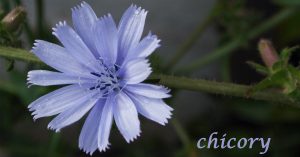Chicory – wild blue beauty
Edited: November 13, 2022

No-one who has seen the perfect sky-blue flowers of the chicory plant can ever forget them. A tall woody perennial, it is native to Europe where is grows along roadsides and dry field margins and has been a valued medicinal plant for centuries. It now grows happily on every continent where all parts of the plant are used in cuisine and medicine.
Famous as a caffeine-free addition to or substitute for coffee, the chicory root has so much more to offer to the herbalist. It is a valuable digestive aid and can help to reduce stomach acid, soothing acid reflux and aiding digestion. An extract from chicory root called inulin is used in modern medicine as a sweetener valuable in the treatment of diabetes, and as a tonic or cleanser for the liver. Related to the dandelion, chicory is valued for its young leaves and blanched buds which add the bitter flavour prized by Ayurvedic practitioners and so often lacking in the Western diet. The roots of the chicory plant are a treasure trove of prebiotics and biochemicals that treat and balance our bodies. They were traditionally grown as foraging for domestic animals who, like us, benefit from nature’s pharmacy.
This summer look out for the lovely cerulean blue flowers along the roadsides and hedgerows and wonder at all the benefits this common plant has to offer us.
Another reason not to use toxic sprays and chemicals to eradicate our native and naturalised plants.
(A version of this post was first published on our Facebook page in June 2018)
 Accredited school
Accredited school